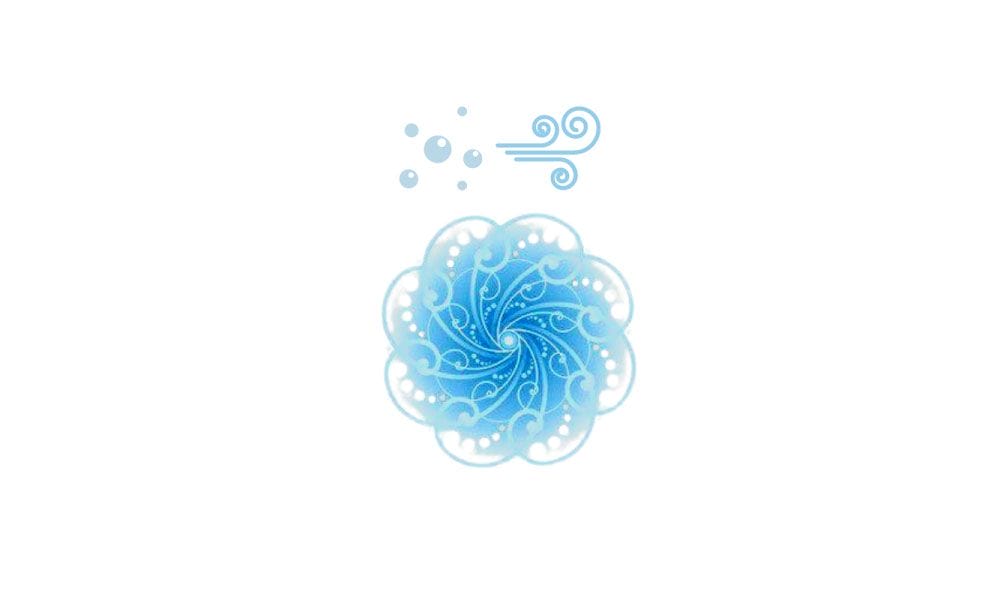Ayurveda is known for its holistic approach to health and wellness and one of the key concepts in Ayurveda is the understanding of Doshas, which are the elemental forces that govern various physiological and psychological functions in the body. There are three Doshas in Ayurveda: Vata, Pitta, and Kapha, and understanding their characteristics and imbalances can help us maintain optimal health and well-being. [1]
What are Doshas in Ayurveda?
According to Ayurveda, Doshas are the three fundamental energies or forces that make up the physical and mental aspects of our bodies. They are responsible for the functioning of different bodily systems and are composed of the five elements or Mahabhutas, ie. Akasa(Sky or Ether), Vayu(Air), Tejas(Fire), Ap(Water)
and Prithvi(Earth). Each Dosha has its unique qualities, which determine its role in maintaining overall health and vitality. [1]
How can I find my Dosha?
In Ayurveda, the key to a person’s overall health and wellness is believed to be the balance of their Doshas. By understanding the three Doshas and striving for an ideal balance, one can develop and reach their full potential, and overcome health challenges more effectively. You can find out your body’s dominant Dosha by using our Dosha Calculator Tool
The Three Doshas: Vata, Pitta, and Kapha
1. Vata Dosha: The Force of Movement
Vata Dosha is composed of the elements of Akasa and Vayu. It is considered the force of movement and governs all movement in the body, including breathing, circulation, and nerve impulses. Vata is responsible for controlling the movement of muscles, tissues, and organs and is associated with the nervous system and the principle of communication in the body. [2] [3]
Qualities of Vata Dosha:
Cold: Vata tends to be cold in nature, and individuals with dominant Vata Dosha may experience cold hands and feet, and a preference for warm weather.
Dry: Vata is also dry in nature, which can manifest as dry skin, hair, and nails in individuals with a Vata imbalance.
Light: Vata is characterized by lightness, and individuals with Vata dominance may have a slender body frame and a light appetite.
Rough: Vata can also be rough in nature, leading to dry and rough skin, and sometimes constipation. [4]
Psychological Characteristics of Vata Dosha:
In addition to the physical qualities, Vata Dosha also influences our psychological and emotional states. Individuals with a dominant Vata Dosha may exhibit the following psychological characteristics:
Creative and imaginative: Vata is associated with creativity and imagination, and individuals with Vata dominance may have a creative and artistic nature.
Quick-thinking and talkative: Vata governs the nervous system and is associated with quick thinking and fast-paced speech.
Anxious and fearful: When Vata is imbalanced, it can lead to anxiety, fear, and restlessness. [2] [4] [5]
2. Pitta Dosha: The Force of Transformation
Pitta Dosha is composed of the elements of fire and water. It is considered the force of transformation and is responsible for all metabolic and enzymatic activities in the body. Pitta governs digestion, absorption, assimilation, and temperature regulation, and is associated with the digestive system and the principle of transformation in the body. [2] [3]
Qualities of Pitta Dosha:
Hot: Pitta is hot in nature and individuals with dominant Pitta Dosha may have a strong appetite, a preference for cooler climates, and a warm body temperature.
Oily: Pitta is also oily in nature, and individuals with Pitta dominance may have oily skin and hair.
Sharp: Pitta is characterized by sharpness, and individuals with a dominant Pitta Dosha may have sharp features and a sharp intellect.
Penetrating: Pitta can be penetrating in nature, leading to a strong and focused mind. [4]
Psychological Characteristics of Pitta Dosha:
In addition to the physical qualities, Pitta Dosha also influences our psychological and emotional states. Individuals with a dominant Pitta Dosha may exhibit the following psychological characteristics:
Ambitious and goal-oriented: Pitta is associated with drive, determination, and ambition, and individuals with a Pitta dominance may be highly motivated and goal-oriented.
Competitive and assertive: Pitta governs our ability to be assertive and competitive, and individuals with Pitta dominance may have a strong sense of assertiveness and competitiveness.
Irritable and angry: When Pitta is imbalanced, it can lead to irritability, anger, and frustration. [2] [4] [5]
3. Kapha Dosha: The Force of Stability
Kapha Dosha is composed of the elements of water and earth. It is considered as the force of stability and provides structure and support to the body. Kapha governs stability, growth, and lubrication in the body, and is associated with the respiratory system and the principle of stability in the body. [2] [3]
Qualities of Kapha Dosha:
Cold and damp: Kapha is cold and damp in nature, and individuals with dominant Kapha Dosha tend to develop cold and damp characteristics, such as feeling cold easily or having excess mucus production.
Heavy: Kapha is heavy in nature, and individuals with Kapha dominance may have a heavier body frame and a slower metabolism.
Smooth: Kapha is characterized by smoothness, and individuals with a dominant Kapha Dosha may have smooth, glowing skin and glossy hair.
Stable: Kapha provides stability, and individuals with Kapha dominance may exhibit stable and consistent behaviours. [4]
Psychological Characteristics of Kapha Dosha:
In addition to the physical qualities, Kapha Dosha also influences our psychological and emotional states. Individuals with a dominant Kapha Dosha may exhibit the following psychological characteristics:
Calm and grounded: Kapha is associated with calmness, stability, and groundedness, and individuals with Kapha dominance may have a calm and composed demeanour.
Content and nurturing: Kapha governs our ability to be nurturing and caring, and individuals with Kapha dominance may have a nurturing and contented nature.
Resistant to change: Kapha can also lead to resistance to change and a tendency to stick to routines and habits. [2] [4] [5]
Understanding Dosha Imbalances
According to Ayurveda, imbalances in the Doshas can lead to various health issues and can be the root cause of many diseases. When a Dosha becomes excessive or deficient in the body, it can disrupt the natural equilibrium and harmony, leading to physical, mental, and emotional imbalances. It is important to recognize the signs of Dosha imbalances and take appropriate steps to restore balance and well-being. [1]
Imbalances in Vata Dosha:
When Vata Dosha is imbalanced, it can manifest in the following ways:
Digestive issues: Vata imbalance can lead to irregular digestion, bloating, constipation, and gas.
Dryness: Vata imbalance can cause dryness in the skin, hair, nails, and mucous membranes.
Anxiety and restlessness: Vata imbalance can lead to increased anxiety, restlessness, and nervousness.
Insomnia: Vata imbalance can disrupt sleep patterns and lead to difficulty in falling asleep or staying asleep. [4]
Imbalances in Pitta Dosha:
When Pitta Dosha is imbalanced, it can manifest in the following ways:
Digestive issues: Pitta imbalance can lead to hyperacidity, heartburn, and inflammation in the digestive tract.
Skin issues: Pitta imbalance can cause skin rashes, acne, and inflammation.
Anger and irritability: Pitta imbalance can lead to increased irritability, anger, and frustration.
Increased body heat: Pitta imbalance can cause increased body heat, excessive sweating, and sensitivity to heat. [4]
Digestive inflammation: Pitta imbalance can lead to inflammation in the digestive system, including conditions like gastritis and colitis. [4]
Imbalances in Kapha Dosha:
When Kapha Dosha is imbalanced, it can manifest in the following ways:
Weight gain: Kapha imbalance can lead to weight gain and sluggish metabolism.
Excessive mucus production: Kapha imbalance can cause excess mucus production in the respiratory tract, leading to conditions like allergies, sinus congestion, and asthma.
Lethargy and depression: Kapha imbalance can cause lethargy, low energy, and depressive symptoms.
Slow digestion: Kapha imbalance can lead to slow digestion, poor appetite, and heaviness after meals. [4]
Restoring Dosha Balance
Ayurveda emphasizes the importance of maintaining a state of balance among the Doshas to promote optimal health and well-being. When Doshas are imbalanced, Ayurveda recommends a holistic approach to restore balance, which may include dietary and lifestyle modifications, herbal remedies, and other Ayurvedic therapies. Here are some general guidelines for balancing the Doshas:
Vata Dosha:
Keep warm: Vata Dosha is aggravated by cold and dry weather, so it’s important to stay warm and avoid exposure to cold drafts.
Eat warm, nourishing foods: Include warm, cooked foods in your diet. Avoid raw and cold foods. Examples include dairy, nuts, fats, root vegetables, and mild spices like turmeric. Consume herbal preparations with Ashwagandha.
Follow a routine: Establish a routine that avoids taking too much stress and allows for timely meals, sleep, and exercise to help stabilize Vata Dosha.
Practice grounding activities: Engage in grounding practices such as yoga and meditation to calm the restless nature of Vata Dosha.
Stay hydrated: Drink warm liquids throughout the day, such as warm water or herbal teas, to counteract the dryness associated with Vata Dosha. [4] [5]
Pitta Dosha:
Avoid spicy and hot foods: Pitta Dosha is aggravated by spicy, hot, and oily foods. Opt for cooling, sweet, and bitter foods in your diet. Examples include sweet fruits, raw vegetables, rice, wheat, leafy greens, etc. Avoid strong spices and limit the consumption of salt and fats.
Stay cool: Pitta Dosha is aggravated by heat, so avoid excessive exposure to the sun and hot temperatures. Treatments that use cooling herbs like neem and aloe vera can have a soothing effect.
Practice relaxation techniques: Engage in relaxation techniques such as meditation, deep breathing, and gentle exercise to calm the fiery nature of Pitta Dosha.
Stay hydrated: Drink plenty of water throughout the day to balance the heat associated with Pitta Dosha.
Manage stress: Pitta Dosha can be aggravated by stress, so practice stress-management techniques such as yoga, mindfulness, and adequate rest. [4] [5]
Kapha Dosha:
Stay active: Kapha Dosha tends to be sluggish, so engage in regular physical activity to stimulate metabolism and circulation.
Eat light and warm foods: Opt for light, warm, bitter, and spicy foods in your diet to counteract the heaviness associated with Kapha Dosha. Avoid heavy, oily, and cold foods. Examples include bitter green vegetables like bitter gourd(karela), hot peppers like chillies, light grains like rice, etc.
Practice invigorating exercises: Engage in invigorating exercises such as brisk walking, jogging, or dancing to counteract the lethargy of Kapha Dosha.
Stay warm and dry: Kapha Dosha is aggravated by cold and dampness, so it’s important to stay warm and dry, especially during the colder months.
Stay mentally stimulated: Engage in activities that stimulate the mind and promote mental clarity, such as reading, solving puzzles, and learning new skills. [4] [5]
FAQs
1. Can someone have equal dominance of all three Doshas?
Yes, it is possible for someone to have equal dominance of all three Doshas. This is known as a tridoshic constitution, and it is considered rare. However, even in tridoshic individuals, one or two Doshas may still be more dominant or prone to imbalance depending on various factors such as age, diet, lifestyle, and environment.
2. Can Dosha imbalances change over time?
Yes, Dosha imbalances can change over time due to various factors such as diet, lifestyle, stress, environmental changes, and ageing. For example, a person with a Vata-Pitta constitution may develop a Kapha imbalance later in life due to a sedentary lifestyle or diet high in heavy and oily foods. Therefore, it’s important to regularly assess and maintain Dosha balance through appropriate lifestyle and dietary choices.
3. Are there any risks or side effects associated with Ayurvedic treatments for Dosha imbalances?
Ayurvedic treatments for dosha imbalances can be safe and effective when done under the guidance of a qualified Ayurvedic practitioner. However, like any form of medicine, there are potential risks and side effects associated with certain Ayurvedic treatments, especially when used improperly or without professional guidance. For example, some herbal remedies may interact with medications or have contraindications, and detoxification practices should be done under the guidance of a qualified practitioner to avoid potential adverse effects.
4. Can Ayurvedic remedies and practices be used alongside conventional medical treatments?
Ayurveda can be used alongside conventional medical treatments, but it’s important to consult with both an Ayurvedic practitioner and a conventional healthcare provider to ensure safe and effective integration. Ayurvedic remedies and practices should not be used as a replacement for conventional medical treatments, especially for serious or life-threatening conditions.
Conclusion
In conclusion, understanding the three Ayurvedic Doshas – Vata, Pitta, and Kapha – can provide valuable insights into our physical, mental, and emotional well-being. By maintaining a state of Doshic balance through lifestyle and dietary choices, we can promote optimal health and well-being in a holistic manner. Ayurveda offers a personalized approach to restoring Dosha balance and achieving overall wellness, making it a valuable system of medicine for those seeking a holistic approach to health and wellness.
Disclaimer: This article is written from an Ayurvedic and general knowledge perspective only and does not constitute medical advice. Kindly seek the help of a trained medical practitioner before initiating any treatment.
References:
- Combination-of-TriDoshas-in-different-groups-of-people.pdf (researchgate.net)
- Understanding personality from Ayurvedic perspective for psychological assessment: A case – PMC (nih.gov)
- Relationships among classifications of ayurvedic medicine diagnostics for imbalances and western measures of psychological states: An exploratory study – ScienceDirect
- Ayurveda: Mother of Traditional Medicine
- Prakriti and its associations with metabolism, chronic diseases, and genotypes: Possibilities of new born screening and a lifetime of personalized prevention (researchgate.net)























